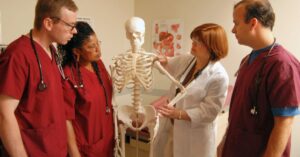In today’s fast-paced healthcare environment, effective communication and quick comprehension of medical procedures are essential for nurses. Visual Guides to Understanding Medical Procedures: A Nurse’s Essential Resource have emerged as an invaluable tool for bridging the gap between theory and practice. These guides not only enhance learning but also improve patient care by simplifying complex procedures, fostering better understanding, and supporting clinical decision-making.
This comprehensive article explores the importance of visual guides in nursing education and practice, their various types, benefits, practical applications, and tips for incorporating them into your daily routine. Whether you’re a new graduate or a seasoned professional, these visual resources can transform the way you approach patient care and medical procedures.
In This Article
The Role of Visual Guides in Nursing
Enhancing Understanding and Retention
Visual guides such as diagrams, flowcharts, and infographics translate complex medical procedures into easy-to-understand visuals. Research shows that visual learning aids retention and comprehension vital for nurses who must quickly recall detailed steps during high-pressure situations. By breaking down information into digestible visual chunks, these guides help nurses remember the sequence of procedures, recognize anatomical structures, and understand physiological processes.
Bridging the Gap Between Theory and Practice
In nursing education, textbooks and lectures provide a strong theoretical foundation, but real-world applications often require rapid decision-making. Visual guides serve as an effective bridge by offering practical, step-by-step instructions that mirror the clinical environment. They enable nurses to visualize procedures such as IV insertions, wound care, and emergency interventions, ensuring that theoretical knowledge is applied accurately and safely.
Supporting Patient Education
Visual aids aren’t just for healthcare professionals they’re also invaluable in patient education. Nurses can use visual guides to explain procedures to patients and their families, making it easier for them to understand treatment plans, risks, and post-procedure care. This not only increases patient compliance but also builds trust and alleviates anxiety.
Types of Visual Guides in Medical Procedures
There are several types of visual guides that serve as essential resources for nurses:
1. Infographics
Infographics are visually appealing representations of data, processes, or instructions. They often combine text, images, and charts to summarize complex information into a clear, concise format. For instance, an infographic on the steps of CPR can provide a quick reference during emergencies.
2. Flowcharts and Diagrams
Flowcharts illustrate the step-by-step process of a procedure. They show the logical flow of actions, decisions, and outcomes. Diagrams, on the other hand, highlight anatomical structures or the placement of medical equipment. These tools are critical for procedures like catheter insertion or interpreting radiographs.
3. Videos and Animations
Moving beyond static images, videos and animated guides offer dynamic, real-time demonstrations of medical procedures. These resources are particularly helpful for visual learners and can be paused or replayed to ensure thorough understanding. Video guides on wound dressing techniques or sterile field preparation can significantly enhance a nurse’s skill set.
4. Interactive Digital Modules
With advancements in technology, interactive modules have become popular in nursing education. These digital resources allow nurses to engage in simulated scenarios where they can practice procedures in a risk-free environment. Interactive modules often include quizzes, real-time feedback, and virtual patient interactions.
5. Illustrated Checklists
Checklists are essential in ensuring that no critical step is overlooked during a procedure. Illustrated checklists combine images with textual instructions, making them a practical tool for everyday use in busy clinical settings. They serve as quick reminders to maintain standards and adhere to protocols.
Key Benefits of Using Visual Guides
Improved Accuracy and Efficiency
One of the primary benefits of visual guides is the increase in accuracy during medical procedures. By having a clear, visual reference, nurses are less likely to miss critical steps. This accuracy translates into improved patient outcomes and greater confidence among healthcare professionals.
Faster Decision-Making
In emergency situations, every second counts. Visual guides provide a quick reference that allows nurses to make informed decisions rapidly. Whether it’s a flowchart for managing cardiac arrest or an infographic on drug dosages, these tools can save precious time during critical moments.
Enhanced Collaboration and Communication
Visual aids foster better communication among interdisciplinary teams. When all team members refer to the same visual resource, it ensures consistency in understanding and implementation. This collaboration is particularly important in complex procedures that involve multiple healthcare providers.
Continuous Learning and Professional Development
For nurses committed to lifelong learning, visual guides serve as a constant reminder of best practices and updated procedures. They can be easily updated with new information and integrated into continuing education programs. This ongoing access to up-to-date resources helps nurses stay current in an ever-evolving field.
Reduction of Stress and Cognitive Load
Complex medical procedures can be overwhelming, especially during busy shifts or in high-stress situations. Visual guides reduce cognitive load by providing clear, straightforward instructions. This reduction in mental effort not only decreases stress but also minimizes the risk of errors.
Practical Applications of Visual Guides in Nursing
At the Point of Care
Visual guides can be displayed in nurses’ stations, patient rooms, and treatment areas as quick reference tools. For example, a laminated flowchart detailing the protocol for managing sepsis can be prominently displayed to ensure timely and effective treatment.
In Simulation Labs
Simulation labs provide a controlled environment for nurses to practice procedures. Incorporating visual guides into these settings can enhance the learning experience by offering real-time, visual feedback. Interactive modules and animated videos are particularly effective during simulation training.
As Part of Orientation Programs
For new nurses, orientation programs can be daunting. Visual guides simplify the onboarding process by providing clear, concise information about common procedures and hospital protocols. This approach not only accelerates learning but also builds confidence among new hires.
For Patient Education
Nurses can use visual aids during patient consultations to explain complex procedures or treatment plans. Whether it’s illustrating the process of administering insulin or explaining the benefits of a surgical procedure, visual guides make medical information more accessible to patients and their families.
Tips for Creating and Using Visual Guides Effectively
Keep It Simple and Clear
When designing visual guides, simplicity is key. Use clear images, concise text, and logical sequences. Avoid overcrowding the guide with too much information, which can lead to confusion.
Update Regularly
Medical procedures and protocols change over time. Ensure that your visual guides are updated regularly to reflect the latest best practices and guidelines. This is crucial for maintaining accuracy and reliability.
Integrate Interactive Elements
Where possible, incorporate interactive elements into your digital visual guides. Interactive modules and videos allow users to engage with the material, enhancing retention and understanding.
Seek Feedback
Encourage your team to provide feedback on the visual guides. Their insights can help you refine and improve the resources, ensuring that they meet the needs of all users.
Use High-Quality Materials
Whether you’re printing a checklist or creating digital content, always use high-quality materials. Clear images and readable fonts are essential for creating effective visual aids.
Future Trends in Visual Medical Guides
As technology continues to advance, the future of visual guides in healthcare looks promising. Virtual reality (VR) and augmented reality (AR) are beginning to play a role in medical training, offering immersive, interactive experiences that can simulate real-life scenarios. These innovative tools have the potential to further enhance learning and improve patient outcomes.
Artificial Intelligence (AI) is also poised to revolutionize visual guides by personalizing content based on individual learning styles and needs. Imagine an AI-driven module that adapts its instructions in real time based on your performance this level of customization could be a game-changer in nursing education and patient care.
Must Read:
- Creative Nursing Graduation Cap Ideas to Celebrate Your Achievement
- Effective Study Tips for Nursing Students: Your Ultimate Guide to Academic Success
- Inspirational Nursing Quotes to Motivate You Every Day
Final Thoughts:
Visual Guides to Understanding Medical Procedures: A Nurse’s Essential Resource have become indispensable in modern healthcare. They simplify complex procedures, enhance learning, and improve communication across multidisciplinary teams. By incorporating these visual tools into your daily practice, you can boost accuracy, reduce stress, and ensure the highest standard of patient care.
As the healthcare landscape continues to evolve, staying current with the latest visual resources will empower you to deliver exceptional care. Whether you’re a seasoned nurse or just starting your career, embracing visual guides is a step toward continuous professional development and improved patient outcomes.
By investing in quality visual guides, staying open to new technologies, and actively seeking feedback, you can ensure that your practice remains at the forefront of modern medicine. Let these resources be your trusted companion in the journey toward excellence in patient care and medical proficiency.







